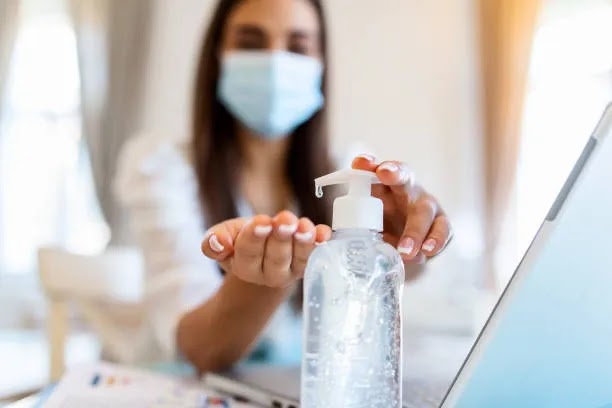Hand sanitizer has become more popular than ever, in large part
due to its effectiveness during the COVID-19 pandemic. Portable hand sanitizer
products kill germs on your hands and other surfaces on contact, helping to
slow the spread of transmissible diseases like COVID-19.
Hand sanitizer has proven to kill germs, but there are some risks
associated with its use. Hand sanitizer overuse can cause dry, cracked skin,
redness or discoloration, and flaking. It can be dangerous if it's ingested or
gets into your eyes.
Let's cover everything you need to know about using hand sanitizer
safely.
Hand sanitizer side effects
The side effects of your hand sanitizer will come down to the
formulas you're using. Hand sanitizer often contains a high amount of alcohol
(60 to 95 percent), killing germs on your hands. Your hand sanitizer may
contain other antiseptic ingredients that have been known to cause negative
effects, even if the alcohol content is low.
Dries out your skin
Alcohol is a proven antiseptic that can kill bacteria and viruses
on organic surfaces. Alcohol, on the other hand, is known to dry out your skin.
When you use hand sanitizer on your hands frequently throughout
the day, the product dehydrates your skin. Dry, flaky, and sensitive skin might
result from this. In addition to being uncomfortable, the American Academy of Dermatology Association says that having dry skin can increase your chances of
picking up germs.
Can trigger and eczema breakout
You may notice that after hand sanitizer dries on your hands, itchy
and red or discolored eczema patches tend to appear. If you have eczema, the
chemicals can make your symptoms worse. You may notice increased eczema
symptoms after using a foam, liquid, or gel-based hand sanitizer.
Can impact your hormones
Hand sanitizer sometimes contains an ingredient called triclosan.
According to the FDA, Triclosan is a bacteria-killing chemical that has been
found everywhere, from toothpaste to body wash. According to the FDA, high
levels of triclosan exposure have been shown in certain studies to disrupt
natural hormone cycles and even affect fertility. More research is needed to
understand triclosan's impact on people fully, but the ingredient has already
been banned from several types of products.
May contribute to antibiotic resistance.
According to the FDA, triclosan is intended to kill bacteria, but
its usage in consumer products may contribute to the growth of
antibiotic-resistant bacteria. According to a 2015 research review of how
triclosan leads to antibiotic resistance, further research is needed to know
how this chemical affects human health.
Hand sanitizer risks
There are risks to using hand sanitizer, especially if you use it
in ways other than the package instructions. These risks can usually be avoided
by using hand sanitizer just on the outside of your hands and avoiding contact
with your eyes.
It can be harmful if swallowed.
The high amounts of alcohol and other ingredients make hand
sanitizer unsafe for human consumption. According to the Texas Medical Center,
anyone who swallows a large amount of hand sanitizer can get symptoms similar
to alcohol poisoning.
It can cause blindness or damage vision if it gets into your eyes.
It's easy enough to apply hand sanitizer and accidentally touch
your eye shortly afterward. However, the high levels of alcohol in hand
sanitizer can cause chemical burns on your eye's outer layer. Typically, damage
caused by hand sanitizer to your eyes will completely heal, but you may
experience the following symptoms while it heals:
- temporarily blurry vision
- pain
- redness
Can you overuse hand sanitizer?
There's a reason why doctors advise against using hand sanitizer
and instead recommend washing your hands with soap and water. It's because it's
very simple to accidentally overdo it with hand sanitizer and cause dry skin
and other side effects.
If you use hand sanitizer so frequently that your hands get dry,
germs from other surfaces may be easier to take up.
Additionally, your skin may start to crack or bleed. Skin that's
dried out and cracked may also be more susceptible to bacteria.
Preventing hand sanitizer poisoning
Before purchasing hand sanitizer, read the ingredient lists and
follow the instructions on the product label. For best results:
- Always supervise children when they use hand sanitizer.
- After use, wait until your hands are completely dry before touching your eyes or face.
- Keep hand sanitizer in a cool, dry place to prevent alcohol evaporation.
- Please don't overdo it. A pump or two from a hand sanitizer dispenser should suffice for your hands.
- Stick to external use only. Never ingest or taste hand sanitizer.
Hand sanitizer benefits and how to use it safely
When used properly, hand sanitizer does have benefits, including:
- quickly kills most types of bacteria on most surfaces
- requires less time to be effective than washing your hands
- is more convenient than soap and water when you don't have access to a sink
Hand sanitizer should only be used when your hands are clean and
free of visible dirt. Rub your hands together until the hand sanitizer has
completely absorbed a dime-sized amount (or less). Apply a moisturizer as soon
as possible once the hand sanitizer has dried for the best benefits (and
healthy skin). This will help prevent some of the less than desirable side
effects.
Takeaway
When hand sanitizer is used correctly, side effects and risks are minimal. When you overuse the product, it can cause dry hands and cracked skin. Some ingredients in hand sanitizer, such as triclosan, might cause health problems if used in large quantities. Always read ingredient labels before you buy and only use hand sanitizer according to the guidance on the product label.


